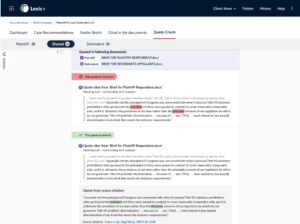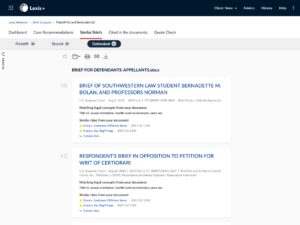It’s a credit to the legal research space that new products are now often judged critically within the context of competitive offerings, and LexisNexis’ new Judicial Brief Analysis (JBA) tool, launched this week, takes some thinking about.
JBA allows you to compare up to six documents – three for each side – and receive one report of all case law arguments, citations and quotes to determine accuracy, relevance and argument strength. It shows you cases that your opponent refers to that you haven’t, and recommends relevant case law that is not already included in your brief to ensure you don’t miss critical cases. It also embeds practical guidance.
The messaging from LexisNexis is that they are mirroring the process that judges and court clerks use when analysing opposing briefs, but that is confusing. The purpose, as with most new tools in the legal research space, is to give attorneys a competitive edge in working out where the gaps are that they can either take advantage of or need to fill.
Information in JBA is presented clearly in a dashboard that shows the case recommendations referred to by the plaintiff, those referred to by the defendant, and those that are shared (referred to by both). While Thomson Reuters has its Quick Check Judicial product, this shared feature is currently unique.
A quote check feature in JBA compares your quotes to the original case citations and tell you if there are any errors. This will flag even minor spacing errors, raising questions (perhaps just to someone no longer practising multi-million dollar litigation?) as to whether the time spent on this is worth it in terms of any change in output or outcome. Speaking to Legal IT Insider, LexisNexis product manager for caselaw, Elizabeth Christman says that any error will be disapproved of by the court, or taken advantage of by the other side, and needs to be remedied.

When it comes to case recommendations, LexisNexis makes recommendations as to cases that are not already referenced, as well as practical guidance and treatises. Christman says: “We show up to 10 case recommendations that are most relevant and that you haven’t already cited. We use technology called word embedding: we apply natural language processing to look for similarities even if not textual similarities, so we map out those passages that have similar meaning and context.”
In terms of LexisNexis own products, JBA is unique – although it builds on core functionality in Brief Analysis, released as part of Lexis+ last year. Christman says that it stands out in the market thanks to the quality of the underlying technology and the calibre and quantity of recommendations. “Because of our vast case law collection and our briefs collection, you can get recommendations on case that don’t exist anywhere else,” she says.
JBA was developed from attorney and court clerk feedback, which is the way that all technology should be developed. We will revisit it down the line in order to weigh up how it has been received by the market, so be sure to contact us with your thoughts.



